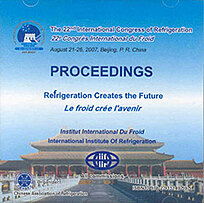
Summary
Effective removal of formaldehyde has become a focus in the field of indoor air quality. The degradation performance of low-concentration gas formaldehyde by titanium dioxide has been studied in a photocatalytical reactor under UV irradiation and a small-scale environmental chamber under fluorescent lamp, respectively. Experimental results show that it takes long time to photodegrade formaldehyde at the experimental conditions and that the degradation efficiency is not high, 77.3% in the reactor and only 33.3% under fluorescent photocatalysis in the chamber. Besides of carbon dioxide, carbon monoxide is also found to be one of the byproducts in the photocatalytic process. The intermediates can not be ignored because they can occupy the active sites of catalyst, leading to the deactivation of the catalyst. The concentration of carbon dioxide and carbon monoxide in gas phase may be even higher than that of formaldehyde if there is much pre-adsorbed formaldehyde in equilibrium before illumination. The ratio of concentration of carbon monoxide to concentration of carbon dioxide ranges between 0.7 and 4.1% during the photodegradation in the reactor, and between 0.1 and 0.6% in the chamber.
Available documents
Format PDF
Pages: ICR07-E1-108
Available
Public price
20 €
Member price*
Free
* Best rate depending on membership category (see the detailed benefits of individual and corporate memberships).
Details
- Original title: Process research on photocatalytic degradation of gaseous formaldehyde by titanium dioxide.
- Record ID : 2008-0773
- Languages: English
- Source: ICR 2007. Refrigeration Creates the Future. Proceedings of the 22nd IIR International Congress of Refrigeration.
- Publication date: 2007/08/21
Links
See other articles from the proceedings (839)
See the conference proceedings
Indexing
-
Themes:
Other air-conditioning equipment;
Indoor air quality - Keywords: Oxide; Formaldehyde; Titanium; Air quality; Expérimentation; Air conditioning
-
Evaluation of the effects of ventilation system...
- Author(s) : GONDO T., ARAI Y., TAKEHIRO E., et al.
- Date : 1999/08/09
- Languages : English
View record
-
Photocatalytic degradation of low concentration...
- Author(s) : LI Z. W., LIU Y. H., DONG S. P.
- Date : 2007/08/21
- Languages : English
- Source: ICR 2007. Refrigeration Creates the Future. Proceedings of the 22nd IIR International Congress of Refrigeration.
- Formats : PDF
View record
-
Modelling approaches for indoor air VOC emissio...
- Author(s) : HAGHIGHAT F., HUANG H. Y., LEE C. S.
- Date : 2005
- Languages : English
- Source: ASHRAE Transactions. 2005 Winter Meeting. Volume 111, part 1 + CD-ROM.
View record
-
Feasibility investigation of a ventilation syst...
- Author(s) : XIAO D., LIU Q., YUAN Q., et al.
- Date : 2007/08/21
- Languages : English
- Source: ICR 2007. Refrigeration Creates the Future. Proceedings of the 22nd IIR International Congress of Refrigeration.
- Formats : PDF
View record
-
Determination of building materials' transport ...
- Author(s) : YANG M., DANG T. Q., ZHANG J. S., et al.
- Date : 2005
- Languages : English
- Source: ASHRAE Transactions. 2005 Winter Meeting. Volume 111, part 1 + CD-ROM.
View record
